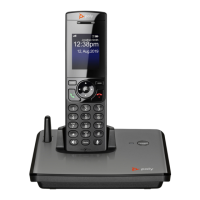Call Routing
37
● <elements:literals> – Substitute the digit sequence matching elements with the given literals.
Single quote syntax isn’t needed or allowed for the literals in this context. Special characters can be
used here as they don’t apply in this context either. Elements can be empty, in which case the ‘:’ can
be omitted. This case is useful for inserting some extra digits in certain part of the dialed digits. The
literals part can be empty also but the ‘:’ MUST NOT be omitted. This case is useful for removing
part of dialed digits. Elements and literals MUST NOT be both empty.
● (map) – An embedded digit map for matching subsequent digits.
● (Mlabel) – A named embedded digit map for matching subsequent digits, where label is one of
abbreviated terminal names. Possible choices are:
(Msp1) for SP1 Service::DigitMap
(Msp2) for SP2 Service::DigitMap
(Msp3) for SP3 Service::DigitMap
(Msp4) for SP4 Service::DigitMap
(Msp5) for SP5 Service::DigitMap
(Msp6) for SP6 Service::DigitMap
(Msp7) for SP7 Service::DigitMap
(Msp8) for SP8 Service::DigitMap
(Mpp) for OBiTALK Service::DigitMap
Starting with release 1.2, the following elements are added:
● X – A wildcard digit that matches 0–9 or *. This is equivalent to [x*] or [0-9*x]
● @ – A wildcard character that matches any alphanumeric character except #
● x? – matches 0 or 1 x
● @? – matches 0 or 1 @
● [^…] – matches any single alphanumeric character that isn’t in the set
● Allow alphanumeric and wildcard inside a set [ ], such as [x], [X#], [@#], [a-zA-Zx]
The last two elements imply that the device digit maps are recursive. Recursive digit maps allow digit maps
to be re-used and make their specification more compact and readable. It is important that you don’t specify
digit maps that lead to infinite recursion. For example, a digit map must not include a named embedded digit
map that references itself.
To bar users from calling numbers that match a rule, add a ‘!’ in front of that rule in the digit map. The rule
is then referred to as a barring rule.
Examples:
●
1408xxxxxxx
– Matches any 11-digit number that starts with 1408.
●
011xx.
– Matches any number that starts with 011 followed by one or more digits.
●
<1408>xxxxxxx
– Matches any 7-digit number. The device prepends 1408 to the number when
making the call.
●
<:1408>xxxxxxx
– Equivalent to the last example.
●
<+>1xxxxxxxxxx
– Prepends ‘+’ to any 11-digit number that starts with 1.
●
<**1:>1408xxxxxxx
– Matches any number that starts with **11408 followed by 7 digits. The device
removes the **1 prefix when making the call.
●
*74(x|xx)
– Matches any number that starts with *74, followed by 1 or 2 digits.

